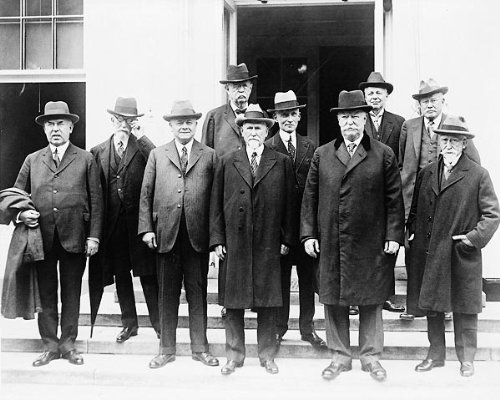
Chief Justice Taft and several Circuit Court judges, gathering for their annual conference, call upon President Coolidge at the White House.
“Courts are established, not to determine the popularity of a cause, but to adjudicate and enforce rights. No litigant should be required to submit his case to the hazard and expense of a political campaign. No judge should be required to seek or receive political rewards.”
Courts do not decide issues, as much as we would like them to or actually take upon themselves to do at times. Courts are political institutions and yet they are not to serve as official polls to endorse or set aside popular opinion on the latest “hot button” topic or current news item. The Courts do not exist to decide “trial balloon” cases floated through the system merely for the purpose of registering approval or disapproval on x, y, or z, influencing how people are to think, using the sanctity of law to amend whatever someone, somewhere does not like about our political and economic structure. Used as a short-cut to change culture, transform institutions we do not like and amend laws without resort to Congress, amendments or even elections, the Courts are allowed to stray far and wide from their original purpose. They do not exist to determine the rightness or wrongness of our every decision, every act, or every thought, relieving us of those terrible burdens known as conscience and self-government. Coolidge understood that the courts were there to hear the facts brought to them so that justice is done to both parties, rights are enforced and the party infringing those rights is held liable as the law requires. Cases are not to subjected to judicial grandstanding carrying political or philosophical arguments out into the public sphere to pressure different outcomes or enhance social standing. A fundamental grasp of true justice to all concerned demands something far better than that. That is equally as true whether your name is Scalia or Breyer.
“If I appoint him as a judge, can he see the issues of the case over the heads of the parties? I do not intend to appoint any man to the Superior Court, or to any court, who cannot do that.”
It is not the role of a judge to empathize, to be able to emotionally identify with or personally relate to the situation faced by either party in a case. This is irrelevant to the work a judge is to do. By appointing judges on the basis of their subjective quantity of “compassion,” specific skin color, proximity to poverty, gender or, as Coolidge would say, things that are non-essential to qualification for this important work, it debases justice itself and thereby deprives either party of a righteous and fair result. It expects courts to no longer look past the particulars of the persons involved with even an attempt at objectivity and impartiality — the blindfold — of real justice. Instead, the facts of the case and the proper application of the law to the question at issue are secondary to how difficult it is to be a poor single mother, a juvenile with prior offenses or a convicted murderer awaiting the death penalty. In short, the legal and factual questions of the particular case under review are barely considered, if at all. The decision, instead, devolves upon how badly do the men and women of the Court feel for either party on a given day. By adhering to what the court is supposed to do – apply the provisions of the law to the facts of the case — compassion and justice retain their proper balance and proportions, victims find remedy and guilt is held accountable. That is the profound and indispensable purpose of judging. While Coolidge appointed the best jurists he could find by this standard, their failure at times to uphold it hardly invalidates the rule he applied or makes Cal inconsistent, it confirms the supreme importance of judging our judges well before we bestow them greater responsibilities.